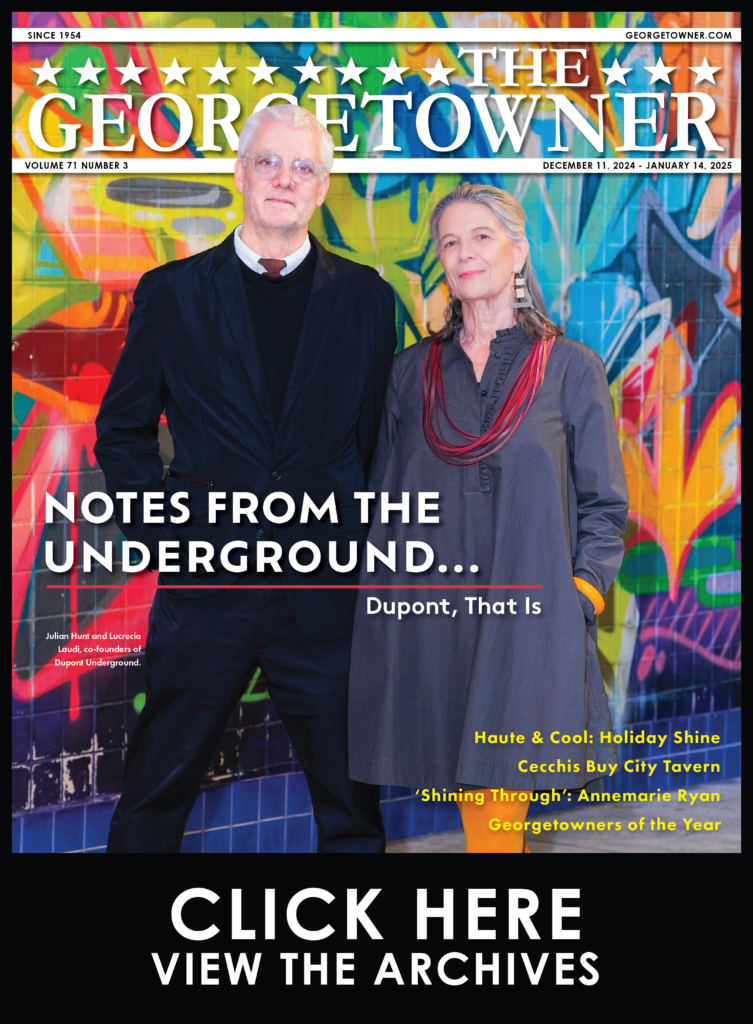Summer Reading Suggestions
By • June 23, 2022 0 1563

With the beach season upon us, we asked our staff to recommend some good summer reads. Hope you enjoy snuggling up to a good book. Let us know if you have some good recommendations at editorial@georgetowner.com.
By Peggy Sands
Detective Mysteries for Tweens-to-Eighty Somethings
When real news gets overwhelmingly dire, there’s nothing like a good detective story by a good writer to ease the stress. The novels by favorites John Grisham and Martin Walker – exceedingly popular writers from the D.C. area – always please.
Martin Walker combines his long professional experience in U.S. intelligence and D.C. think tanks with his contagious passion for the cooking, wines and people of southwest France — the Dordogne. Walker’s charming local Police Chief Bruno Courreges is the consummate local cop: there is hardly a family or shop in his jurisdiction he hasn’t spent social time with, often over the region’s glorious foods. His local knowledge inexorably helps him solve crimes in his region’s historic French villages beset with modern problems. One of my favorite Bruno books is “A Taste of Vengeance” where Bruno faces international terrorists, murder and money laundering as well as the pregnancy of a local young soccer star on the brink of being selected for the national women’s team and facing an abortion in a traditional Catholic village. Walker’s book endings are always highly satisfactory.
My big discovery this year is a series of legal mysteries by America’s favorite writer John Grisham, written over the past ten years from the viewpoint of a 14-year-old boy in a middle-American small town. “Theodore Boone” is the precocious thoroughly likable only child of two small town lawyers. He loves hanging out at the court – even helping friends (and the school librarian) with their problems in the pet court where no attorney’s license is required. His respect for his parents (and his infamous uncle, a debarred lawyer) but also normal endeavors to be independent of them, leads him to confront school and community crises often involving his highly diverse friends. Books in the series that I’ve sent to my tween grandchildren are all highly readable, credible, sympathetic and relatable: Kid Lawyer, The Activist, The Accused, the Abduction and the Fugitive.
—
By Kate Oczypok
“Where the Crawdads Sing,” by Delia Owns. After hearing that Taylor Swift has written a song to go with the movie version of this book out this July (along with the fact that the book made Reese Witherspoon’s book club picks) I was intrigued. I read it in about a week, it was so good and draws you right into the story. – Fiction. 368 pages.
“The School for Good Mothers,” by Jessamine Chen. I originally heard about this book through The Today Show and Jenna Bush Hager’s Book Club. I was instantly sucked into the terrifying, dystopian novel. Fiction. 336 pages.
—
By Susan Bodiker
I’ve been on a bit of a medical jag lately. Here are some of my recent faves:
“Silent Invasion,” Dr. Deborah Birx. An apologia pro vita sua on her time with Trump during the early days of Covid. Non-Fiction. 506 pages.
“The Emergency,” Dr. Thomas Fisher. A wunderkind of medicine recounts his experiences on the South Side of Chicago, a start-up and the Obama White House. Non-Fiction. 255 pages.
“The Invisible Kingdom,” Meghan O’Rourke. A loooong but gripping account of her life with chronic illness. Non-Fiction. 324 pages.
“Bomb Shelter,” Mary Laura Philpott. Essays on “life, death, and existential fear.” (It’s actually funny.) Memoir. 275 pages.
“Yonder,” Jabari Asim. A haunting re-imagining of life among enslaved people in the ante-bellum South. Fiction. 255 pages.
—
By Christopher Jones
“The Library Book,” by Susan Orlean. From the brilliant New Yorker writer of “The Orchid Thief,” this romp about the worst library fire in the history of the U.S., at the Los Angeles Public Library in 1986 is much more than simply a meditative essay on the vital importance of libraries in the public sphere; it’s a whodunnit filled with colorful, fascinating characters, and a thrill-ride (yes, really) for all who still ache over the burning of the great Library of Alexandria and who thrill to the potentials of the hive mind. Check it out! – Non-Fiction. 310 pages.
“Chasing History: A Kid in the Newsroom,” by Carl Bernstein. A candid personal memoir of 17 year-old Carl Bernstein – a struggling high school student from Montgomery County, Maryland – joining Washington D.C.’s Evening Star newspaper as an entry-level copy boy and doggedly training his mind to rise through the ranks of one of America’s great newspapers. Eventually, of course, Bernstein rises to become the world-class investigative journalist who worked with Bob Woodward at The Washington Post to expose President Nixon’s Watergate crimes. But this tale – written with a light, humorous and insightful touch – is woven around so many more great topics: segregation and race in the nation’s capital, the Kennedy and Johnson eras, the Cold War, youthful romance and mischief, local history of the DelMarVa region, and the thrill of journalism in a time when the great city papers pumped out five editions per day. Read all about it! – Non-Fiction. 345 pages.
“Circe,” by Madeline Miller. Fiction. 391 pages. From the best-selling author of “The Song of Achilles,” this elaborate re-imagining of the Homeric legends is told from the perspective of the cast-aside goddess/witch Circe, upon whose island heroic Odysseus is stranded as he attempts to return from the Trojan War to Ithaca and his loyal wife, Penelope. While a synopsis of the tale’s premise may sound like a simple turning-of-the-tables toward a feminist paradigm, the story itself is richly evocative, poignant, and loaded with the many colorful and baffling figures from across the various dimensions of the Greek myths. It’s not only a powerful story of a strong female character’s struggles and conquests, but a great primer on the classical Greek mind.

